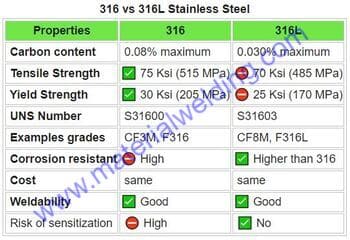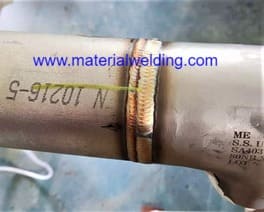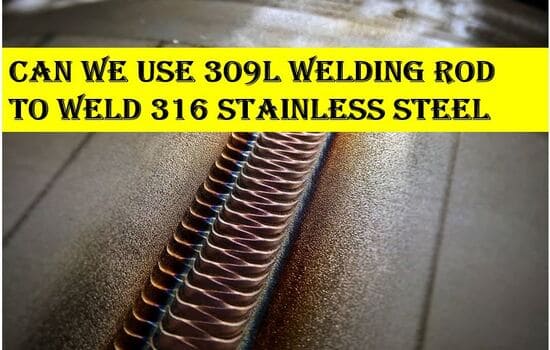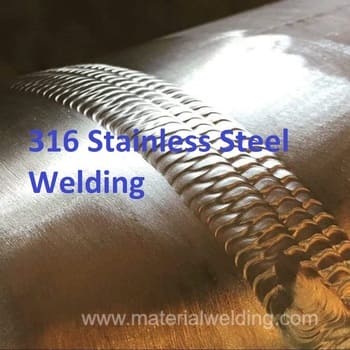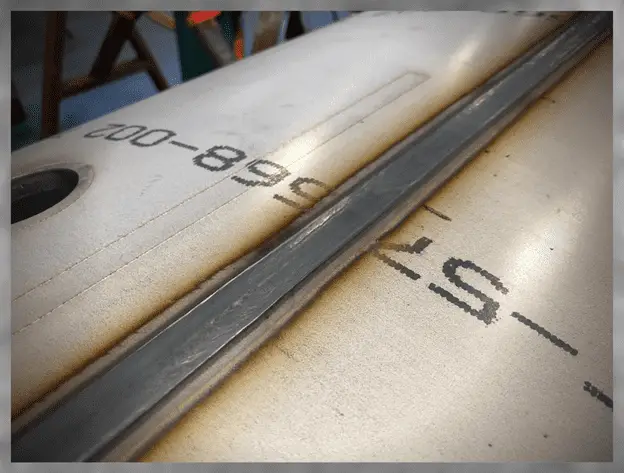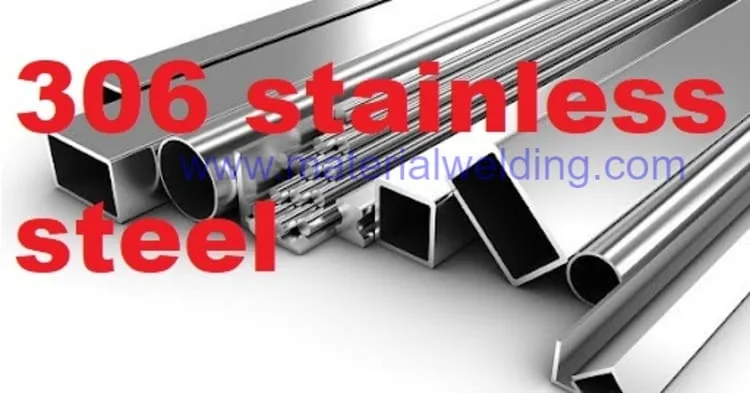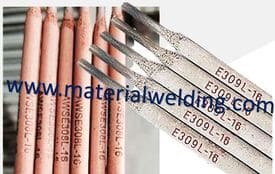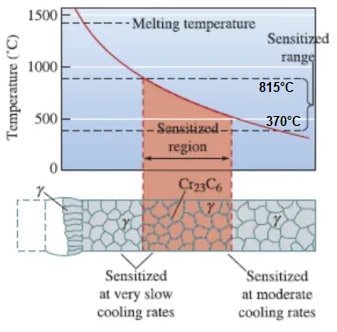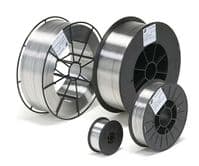316L Stainless Steel
316L stainless steel is a low-carbon variant of 316 stainless steel. It has the same chemical composition as 316 stainless steel, but a lower carbon content.
This makes it less susceptible to corrosion and staining. 316L stainless steel is often used in applications where low carbon content is important, such as the oil & gas sector, piping, food & beverage equipment, and pharmaceuticals.
316 & 316L Material Specification
The UNS Number of Stainless Steel Grade 316 is S31600. The UNS Number of Stainless Steel Grade 316L is S31603.
The main material specifications and type of material form for 316L Stainless Steel is given in the below table:
| Material Specification | Type of material form |
| ASTM A240 | Plate, sheet, strips |
| ASTM A 182 | Flange, Fittings, Valves |
| ASTM A 213 | Seamless Tubes |
| ASTM A 249 | Welded Tubes |
| ASTM A 276 | Bars & Shapes |
| ASTM A 312, A409 | Welded Pipes |
| ASTM A 358 | EFW Pipes |
| ASTM A 376 | Seamless Pipes |
| ASTM A 403 | Wrought Fittings |
| EN 10088-2 | X2CrNiMo17-12-2 (1.4404) |
316L equivalent Material
316L stainless steel is a popular choice for many applications because it is strong and resistant to corrosion.
However, some projects require a material that has even greater corrosion resistance. 316L equivalent material is a term used to describe a number of materials that have similar properties to 316L stainless steel.
The equivalent material of AISI 316L are X2CrNiMo17-12-2 (1.4404), AFNOR Z2CND17-12, SS 2343, JIS SUS316L, GOST 03Ch17N13M2.
If you are looking for a material that has superior corrosion resistance than 316L stainless steel, be sure to consider Hastelloy C-276 or Inconel 625.
316L stainless steel Chemical properties
316L stainless steel is a low carbon austenitic stainless steel. It has excellent corrosion resistance in a wide range of environments.
316L stainless steel is non-magnetic in the annealed condition, but can become slightly magnetic after cold working. It is also less susceptible to fingerprinting and staining than other alloys.
The chemical composition of Stainless Steel 316 and Stainless Steel 316L Grades are given in the below Table:
| Grade | 316 | 316L |
| Element | Weight % | Weight % |
| Carbon | 0.08 | 0.030 |
| Manganese | 2.00 | 2.00 |
| Silicon | 0.75 | 0.75 |
| Chromium | 16 -18 | 16 -18 |
| Nickel | 10- 14 | 10- 14 |
| Molybdenum | 2.0- 3.0 | 2.0- 3.0 |
| Nitrogen | 0.10 | 0.10 |
| Sulfur | 0.30 | 0.30 |
| Phosphorus | 0.045 | 0.045 |
AISI 316L Stainless Steel yield strength
316L stainless steel is a versatile and corrosion-resistant material that is well-suited for many applications. It has a minimum yield strength of 25,000 psi (170 MPa), making it strong and durable.
316L stainless steel can be used in marine environments, food processing, and other applications where durability and corrosion resistance are important.
The Important mechanical properties (Yield strength, Tensile Strength, elongation & hardness) of AISI 316 & AISI 316L according to the ASTM A240 are given in the below table:
| Grade | AISI 316 | AISI 316L |
| Yield Strength, Minimum | 30 Ksi (205 MPa) | 25 Ksi (170 MPa) |
| Tensile Strength, Minimum | 75 Ksi (515 MPa) | 70 Ksi (485 MPa) |
| Elongation, min% | 40 | 40 |
| Hardness, Maximum | 217 HBW (95HRBW) | 217 HBW (95HRBW) |
| Thermal Conductivity | 21.5 W/m·K @ 500 °C/ 932 °F | 21.5 W/m·K @ 500 °C/ 932 °F |
| Thermal Expansion | 17.5 µm/m/°C | 17.5 µm/m/°C |
| Density | 8g/cm3 | 8g/cm3 |
| Young Modulus | 193 GPa | 193 GPa |
| Melting Temperature | 2500 to 2590 °F (1371 to 1421 °C) | 2500 to 2590 °F (1371 to 1421 °C) |
316L Stainless Steel tensile strength
AISI 316L stainless steel is a low carbon austenitic stainless steel that possesses excellent corrosion resistance in a wide range of environments.
Its minimum tensile strength require is 70,000psi (485 MPa), making it a strong and durable choice for applications that require high strength and resistance to wear and tear.
316L thermal expansion coefficient
316L stainless steel is a material with a thermal expansion coefficient of about 17.5 µm/m/°C. This means that the material will expand by about 17.5 µm for every meter it is heated by one degree Celsius.
The thermal expansion coefficient can vary depending on the alloy composition, so always verify the value for the specific grade you are using.
The coefficient is important to consider when designing parts that will be exposed to temperature changes, as they will need to be able to accommodate the expansion without breaking or warping.
316L hardness
316L stainless steel is a popular choice for knife blades because of its combination of toughness and hardness.
While it is not the hardest stainless steel available, it has a hardness of maximum 217 HBW (95HRBW), which is still significantly higher than many other alloys.
This allows it to hold an edge well without becoming brittle, making it a good choice for engineering applications that need to withstand frequent use.
SS316 thermal conductivity
The thermal conductivity of SS316 is 21.5 W/m·K @ 500 °C. This value is significantly lower than that of copper (385 W/(m·K)).
The low thermal conductivity of SS316 can be attributed to its high density and lack of a metallic sheath. In comparison, copper has a much lower density and a metallic sheath that promotes heat transfer.
While the low thermal conductivity of SS316 may be a disadvantage in some applications, it also makes the material less susceptible to corrosion.
316L young’s modulus
316L is a stainless-steel alloy with a young’s modulus of approximately 200 GPa (193 GPa). This makes it relatively stiff, compared to other materials.
316L stainless steel welding
316L stainless steel welding is a popular process that is often used in the manufacturing of food processing equipment, chemical tanks, and other items that are in contact with corrosive materials.
The most common welding process for fabricating items from 316L stainless steel is TIG & MIG welding.
TIG & MIG welding of 316L is carried out using ER316LSi TIG wire using pure argon gas for shielding. Sometimes, small amount of oxygen is added to argon to provide fluidity to the weld pool.
The welding rod or electrode that is used for TIG welding must also be selected carefully. The type of rod that is used will depend on the composition of the weld metal and the desired final properties of the welded joint.
Stick Welding or SMAW welding for AISI 316L is carried out using E316L-15 or -16 or -17 rod. No special precaution is required for welding. Although, welding with low heat input is recommended to avoid welding distortion.
316 Stainless Steel vs 304 Stainless Steel
316 vs 304 stainless steel are both commonly used in a variety of industries. While they may appear to be similar, there are some key differences between the two types of steel.
The most noticeable difference is the level of corrosion resistance. 316 stainless steel has a higher resistance to corrosion than 304 stainless steel, making it a better choice for certain applications.
316 stainless steel and 304 stainless steel are both alloys of steel, but they have different chemistries and properties.
316 stainless steel contains a higher percentage of nickel and molybdenum than 304 stainless steel does, which gives it better corrosion resistance & higher strength at elevated temperature.
It is also more resistant to pitting and crevice corrosion. The higher levels of chromium in 316 stainless steel also give it a higher melting point and make it less susceptible to discoloration
316 stainless steel is a better choice than 304 stainless steel for most applications. 316 has a higher nickel content, which makes it more resistant to corrosion. It is also slightly stronger than 304.
316 stainless steel is a molybdenum-bearing austenitic stainless steel. It exhibits better resistance to pitting corrosion than 304 stainless steel, especially in acidic environments.
In addition, 316 has improved creep and stress corrosion cracking resistance. 316 stainless steel is commonly used in food and beverage applications, chemical processing, and marine environments.
304 stainless steel is a chromium-nickel austenitic stainless steel with good corrosion resistance.
It is the most common type of stainless steel used in construction and manufacturing. 304 stainless steel is generally less expensive than 316 stainless steel and is often used in lower-cost applications.
316L vs 316
316L and 316 stainless steels are both austenitic stainless steels that contain molybdenum. The addition of molybdenum to these alloys improves the pitting and crevice corrosion resistance in most environments.
There are a few key differences between 316L and 316 stainless steels that fabricators should be aware of.
There are some key differences between them in chemistry & mechanical properties with associated corrosion resistance.
316L has a lower carbon content, which makes it less likely to corrode in harsh environments. This also solves the problem of sensitization during welding in 316L compared to 316 grades.
316 has a higher carbon content, making it more durable and heat-resistant compared to 316L. However, it is more susceptible to corrosion in certain environments. Both alloys have similar chemistries except variation in carbon percentage.
Due to higher carbon content, 316 exhibits higher yield and tensile strength compared to 316L as given in the table earlier for mechanical properties comparison.
Overall, both alloys have very similar chemistry and properties.
What does 316L mean on jewelry?
316L is a type of stainless steel that is often used in jewelry. It is corrosion-resistant and has a very low nickel content, so it is ideal for those with allergies. 316L also has a very high quality and can resist tarnishing.
316L is a type of stainless steel that is commonly used in jewelry. It is corrosion-resistant and has a high resistance to tarnishing.
This makes it a popular choice for jewelry pieces that are worn everyday. 316L stainless steel is also hypoallergenic, making it a good option for those with sensitive skin.
316L is a type of stainless steel that is resistant to corrosion. 316L stainless steel is often used in jewelry because it does not corrode or tarnish over time. 316L stainless steel is also a hypoallergenic metal, so it is ideal for people with allergies.
Etchant for 316L stainless steel
316L stainless steel is a popular choice for many applications due to its corrosion resistance. A common etchant for this type of steel is hydrofluoric acid (HF).
However, HF can be dangerous to use and is not always effective. In some cases, nitric acid may be a better choice.
Nitric acid can be more dangerous to use than HF, but it is more effective at removing the chromium oxide layer from the stainless steel.
It is important to use the correct etchant when working with 316L stainless steel, as using the wrong etchant can damage the test specimen or can exhibit no effect.
Is 316 stainless steel magnetic?
316 stainless steel is a popular choice for applications that require a non-magnetic material. However, there is some debate over whether or not 316 stainless steel is actually non-magnetic.
The reason for this confusion is the austenitic microstructure of 316 stainless steel. Austenite is a magnetic phase, but the majority of the material is usually in a non-magnetic state.
There are also small amounts of ferrite and martensite in the microstructure, which are both magnetic phases.
If the ferrite and martensite phases are present in high enough concentrations, the material can become magnetized.
